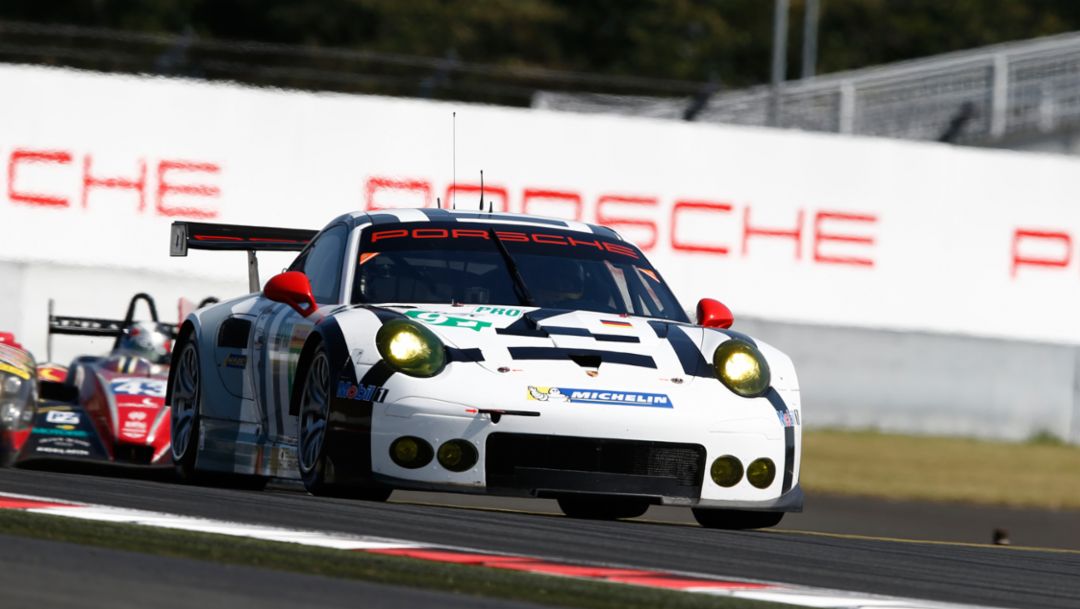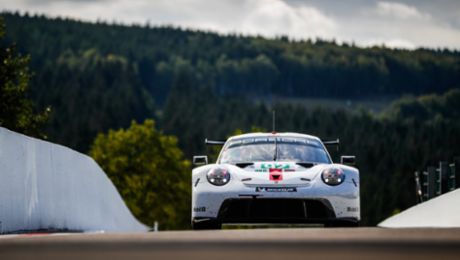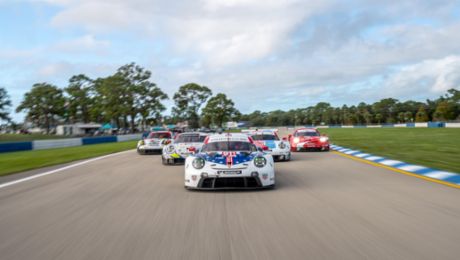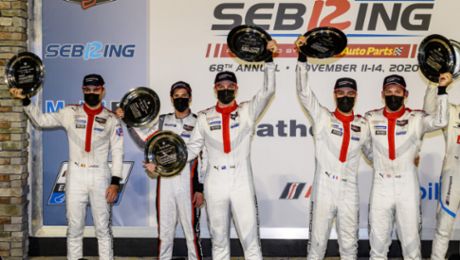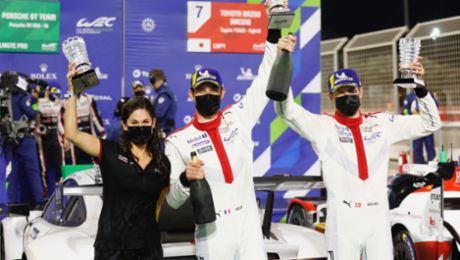WEC-Preview Fuji: season-final starts
At the foot of Mount Fuji the 2015 FIA World Endurance Championship (WEC) enters its critical phase on October 11: The six-hour race on the famous high-speed circuit in the Japanese Alps is the sixth of eight championship rounds.
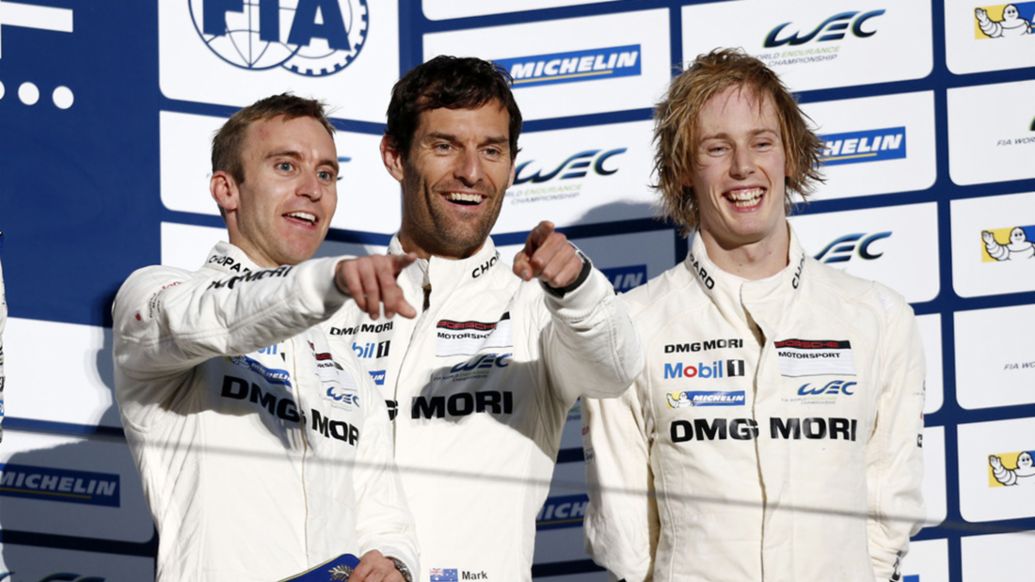
Preview LMP1:
Featuring the longest straight on the calendar – 1,500 metres – but also 16 corners that are relatively tight on a lap of only 4.549 kilometers, the Fuji Speedway is extremely demanding when it comes to set-up work. The Speedway in the Japanese Alps welcomed the FIA World Endurance Championship (WEC) in bright sunshine with temperatures of over 20 degrees Celsius. The Porsche Team had two positive free practice sessions, each 90 minutes long, in preparation for the sixth of eight World Championship rounds. The two Porsche 919 Hybrids with the driver trios of Timo Bernhard (DE)/Brendon Hartley (NZ)/Mark Webber (AU) and Romain Dumas (FR)/Neel Jani (CH)/Marc Lieb (DE) were fourth and second in the morning and first and third in the afternoon.
Thirty one racing cars with 86 drivers from 19 different nations are divided into four classes in the WEC. The Porsche 919 Hybrid competes in the top LMP1 class (class one Le Mans Prototypes) and is a research laboratory for future sports car technology. It is powered by a downsizing two-litre V4-cylinder turbo charged petrol engine and an electric engine, which is fed by two energy recovery systems (brake energy from the front axle and exhaust energy). This unique and ground-breaking powertrain temporarily turns the 919 into a four-wheel drive car with a performance of around 1,000 hp.
Since the 919’s debut back in 2014, it has won four races: Interlagos 2014, Le Mans, the Nürburgring and Austin in 2015. The car has entered 13 races in total and started from pole position nine times. To date, in 2015 no car other than a 919 has made it onto pole position, or for that matter the front row of the grid.
Last year in Fuji, the two Porsche 919s started from P2 and P3. In the race Bernhard/Hartley/Webber came third, despite a puncture early in the race. Back then this was the second podium finish for the 919. Mark Webber’s fastest race lap of 1:27.759 minutes was the icing on the cake. Dumas/Jani/Lieb finished fourth.
Preview GT:
The Porsche Team Manthey also starts in Fuji. After clinching two double victories on the Nürburgring and at Austin, the squad under Olaf Manthey travels as the new series leader to the six-hour race on the tradition-steeped circuit at the foot of Mount Fuji. A pair of 470 hp 911 RSR will be fielded in the GTE-Pro class. Porsche works driver Richard Lietz (Austria) drives the winning racer from Weissach as the frontrunner of the hotly-contested World Endurance Cup for GT pilots. He shares the cockpit of the number 91 Porsche 911 RSR with Michael Christensen (Denmark). So far this season, the duo has scored victory at the Nürburgring and Austin rounds. Their French teammates Frédéric Makowiecki and Patrick Pilet crew the sister 911 RSR (#92).
Two customer teams campaign the 911 RSR in the GTE-Am class, where 2014-homologated GT vehicles compete: Taking up the challenge for Dempsey Proton Racing, the US actor and race driver Patrick Dempsey joins forces once again with Patrick Long (USA) and Marco Seefried. Scoring second at the 24 Hours of Le Mans, they celebrated their greatest success as a team until now. Le Mans outright winner Earl Bamber (New Zealand) again drives for Abu Dhabi Proton Racing, which secured its best result of the season at Austin with second place.
Quotes before the race
Fritz Enzinger, Vice President LMP1: “Our string of three victories in a row is impressive, as is the fact the Porsche 919 Hybrid has been dominating qualifying. However, the most recent race in Austin was a reminder of how fragile success can be with such a highly complex race car. We have to stay very focussed to extend the lead in the manufacturers’ championship and gain ground in the drivers’ standings.”
Dr. Frank-Steffen Walliser, Head of Porsche Motorsport: “Fuji is a track that posed quite some challenges for us last year. We learned from this and now we’re heading to this round even better prepared. Our goal is to earn more points towards the manufacturers’ championship and to further extend our lead in the driver and team classifications.”
Please find quotes of the drivers in the press release under Downloads.
Fact and figures
• A lap of the Fuji International Speedway is 4.549 km long and has 16 corners, ten righthanders and six lefthanders.
• According to the rules, the Porsche 919 Hybrid can produce and use max 4.15 megajoule electricity per lap. At the same time, its fuel consumption per lap is limited to 1.262 kg. In normal racing mode (without any safety car periods) and given its maximum fuel cell capacity of 67.4 litres, the Porsche 919 Hybrid must refuel every 36 laps (max.).
• Refuelling and changing tyres may only be made sequentially, not at the same time. Only two mechanics may work simultaneously when changing tyres. That takes a lot longer than in Formula One, for example.
• Drivers are normally only changed when new tyres are needed.
• WEC rules call for averaging the fastest laps of two drivers in qualifying for the grid positions.
• The Porsche 919 Hybrid has a power system that produces around 1,000 hp. Over 500 hp comes from the two-litre V4 turbo petrol engine, while the e-machine, fed by the recovery systems, delivers more than 400 hp.
• The Porsche 919 Hybrid accelerates from 0-100 km/h within 2 seconds and takes 4.5 seconds to go from 0-200 km/h.
• Four types of tyres can be used: slick tyres for dry conditions, a hybrid tyre (no profile either but softer cover) for mixed conditions, wets and full wets for heavy or extreme rain. The full wet tyre manages to push up to 120 litres of water per second out of the way.
• The Porsche 919 Hybrid was designed and built at the Porsche AG Development Centre in Weissach. A total of 230 team members work there.
• Mount Fuji is an active stratovolcano that last erupted in 1707. It is the highest mountain in Japan at 3,776 metres and is regarded as a holy mountain.
• The circuit is located about 100 kilometres southwest of the capital of Tokyo on the Japanese main island of Honshu.
• In 2005 the circuit was rebuilt for safety reasons and became, once again, the venue for the Japanese Formula One Grand Prix in 2007 and 2008.
• From 1982 to 1988 the Sports Car World Championship had a round in Fuji. In 1983 Stefan Bellof set the fastest ever recorded lap at the wheel of a Porsche 956 in 1:10.02 minutes. This was, however, on the old track layout when a lap was only 4.360 kilometres.
• In 2014 the track was dry on race day. But the weather in the Japanese Alps can be very changeable at this time of the year. In 2013 heavy rain made it impossible to run the WEC race. Not forgotten is the downpour back in 1976 which caused Niki Lauda to pull out of the race and gave the Formula One World Championship title to James Hunt.
